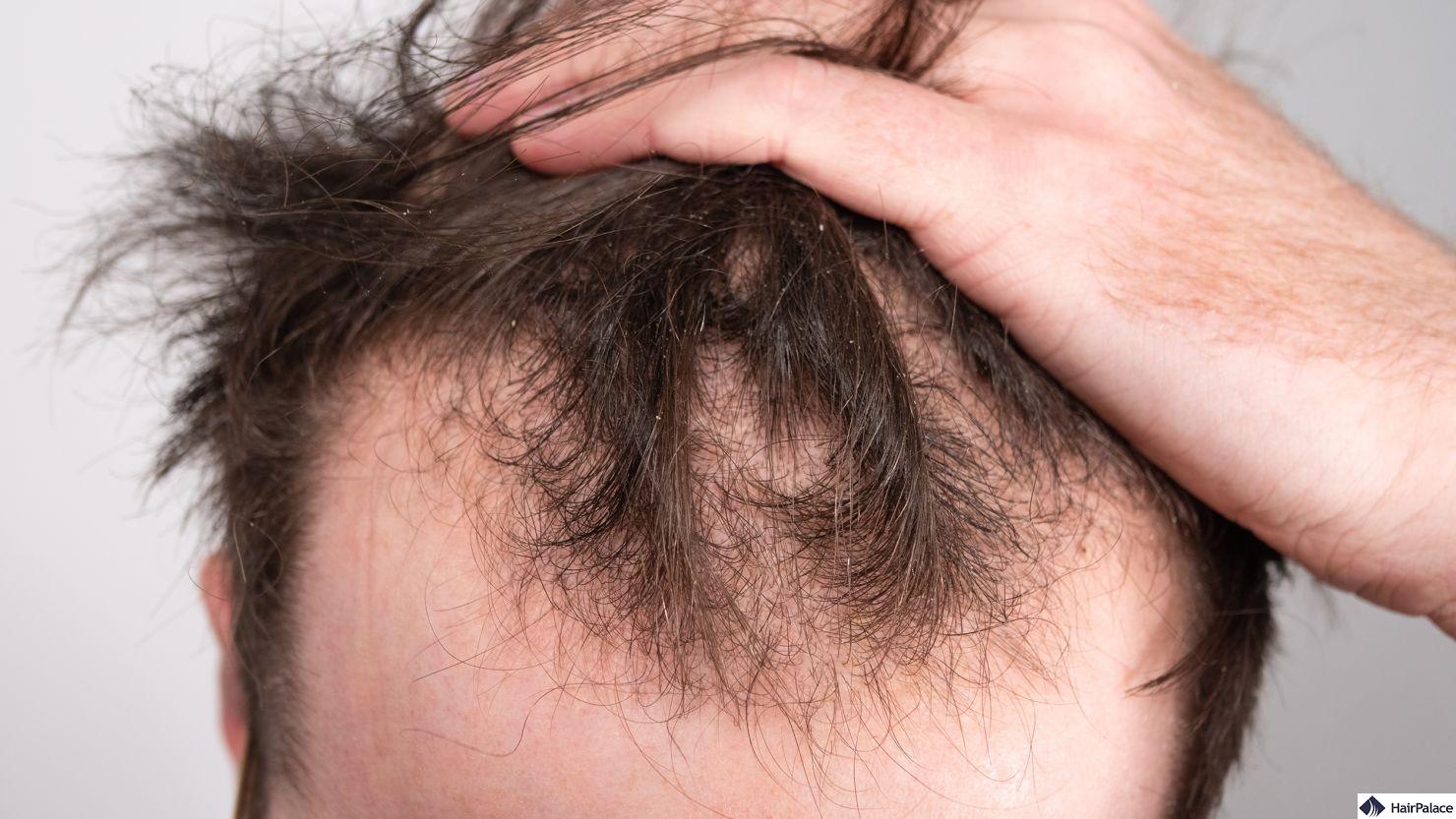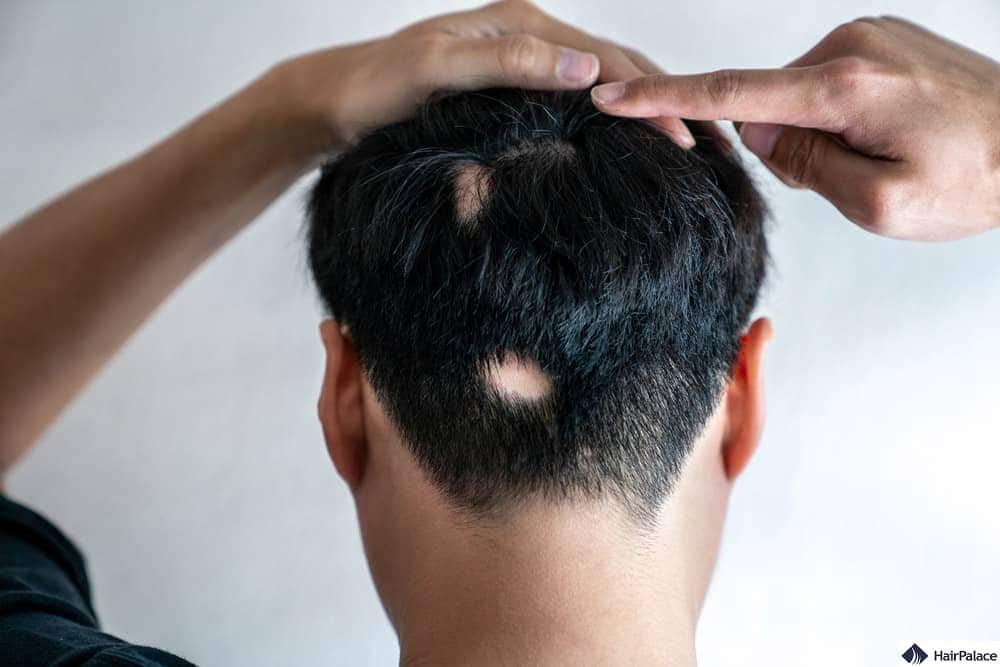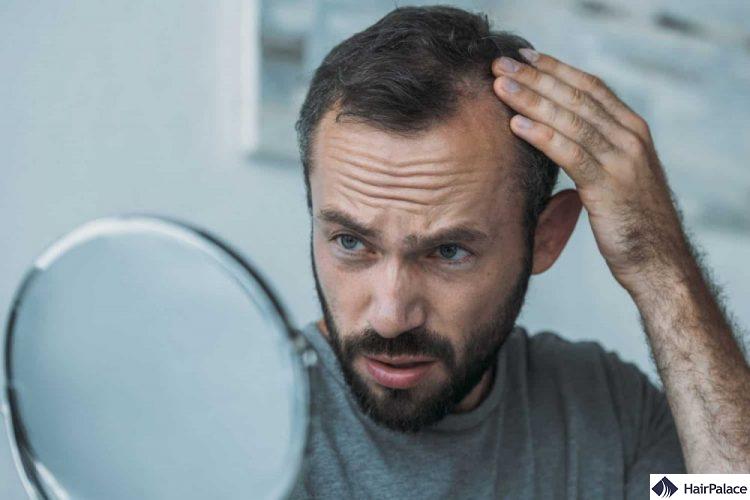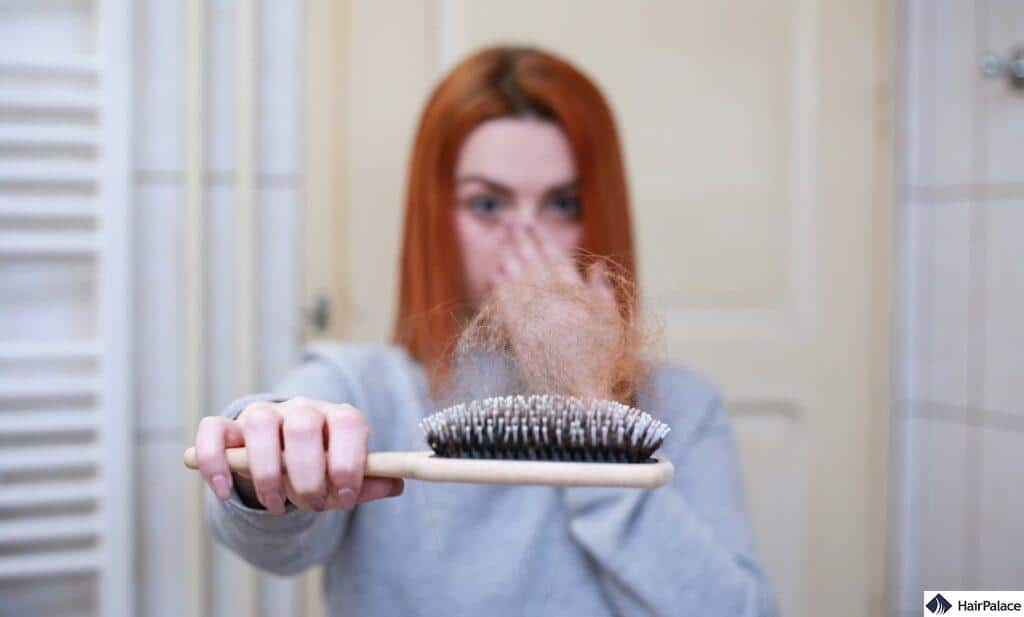Early Signs of Balding: What Are They?

The early signs of balding can appear at any stage of adulthood.
However, the risk of going bald increases as you grow older.
The most common form of hair loss, androgenetic alopecia (pattern baldness), affects around 50% of men aged 50+ and about 40% of women aged 70+.
Early signs of balding include a receding hairline, particularly at the temples, forming an M or V shape, and noticeable thinning on the crown or top of the scalp.
Other indicators are increased hair shedding, widening of the part line, and overall reduced hair volume.
The sooner you spot the signs of baldness, the sooner you can speak to a specialist about potential solutions.
- How much hair loss is normal?
- Early signs
- Signs of hair loss in men
- Signs of female hair loss
- Causes
- Visit a doctor

How much hair loss is normal?
Losing 50-100 strands every day is considered normal hair loss.
Because our scalp has over 100,000 hair follicles, we can stand to lose this amount daily without noticeable hair loss.
Women tend to shed more hair daily than men, and there are exceptions to how much people can lose daily. But altogether, this is the normal amount.
Factors such as how you style your hair, including using straighteners or curling tongs, and if you use harsh chemicals in hair treatments, can also influence the amount of hair falling out.
Early symptoms of hair loss

Although it is perfectly normal to lose hair every day, there is a threshold to be wary of.
Sometimes, significant changes in the density and texture of your hair can signify you’re developing a hair loss condition.
Here are the 5 earliest signs of balding in young men to be mindful of:
1. Thinning Hair
Thinning is a gradual change in the density and texture of your hair. It often starts at the temple or crown of your head, where gradually, less and less hair grows back.
Hair thinning is one of the most common signs of a balding male scalp.
The condition can occur as early as your teenage years, or your twenties. The result can be hair looking sparse, faint, and growing shorter than normal.
2. Receding Hairline
A receding hairline can develop as early as the end of puberty, and by the time someone reaches their late 20s and early 30s, they may already have suffered significant hair loss in prominent places.
For men, a receding hairline often starts just above the temples, where their natural hairline gradually retreats over time.
Hair begins to fall out, forming a V-shape just above the forehead.
3. Hair Falls Out in Clumps
As we’ve already said, losing a certain amount of hair daily is perfectly normal.
But if hair begins to fall out in clumps, or you find a great deal of hair on your pillow in the morning, this can be a significant cause for concern.
If you’ve developed noticeable bald spots or portions of your hair that are easy to pull out when brushing, it’s time to see your doctor.
4. Bald Spots
Sudden bald spots on your scalp may indicate that you’re experiencing alopecia areata.
This is an autoimmune condition that sees your immune system mistakenly attack hair follicles, reducing their growth phase and causing them to fall early.
Alopecia areata can affect your scalp hair, eyebrows, eyelashes, facial hair, and pubic hair across your entire body.
5. You’re Losing Hair All Over Your Body
Losing all of your hair quickly, across your entire body, can be devastating and scary to experience.
Several conditions may cause this, including a subtype of alopecia known as alopecia universalis.
Other causes include autoimmune disorders, iron deficiencies, hormonal disorders involving your thyroid or adrenal glands, diabetes, stress, genetics and for women, and polycystic ovary syndrome.
First signs of balding in men
The Norwood scale illustrates hair loss occurring on multiple parts of the scalp, across 7 main stages of the balding process.
The most noticeable signs of male pattern baldness can show in the following areas:
1. Hairline recession
The majority of men develop a receding hairline with age, this recession may not lead to baldness for everyone.
However, for most, it is one of the earliest signs of male pattern baldness.
The easiest way to identify hair thinning and a receding hairline is to closely examine your scalp in the bathroom mirror or compare photographs.
2. Signs of balding crown
The earliest signs of balding are thinning hair at the temples and on the vertex (or crown), showing as a bald spot on the crown.

3. Thinning on top of the scalp
Hair loss on top of the scalp is usually a slow process, and it’s unlikely to just happen overnight.
You won’t wake up one morning to find most of your hair gone.
Instead, incremental hair thinning may occur over several years until your baldness becomes noticeable.
Signs of balding in women
Female pattern baldness can start to develop between the ages of 12 and 40, though it may begin much later in some cases.
Medical professionals use the Ludwig classification system to identify the following signs of balding in women:
- Widening hair part
One of the most common signs of female balding is a widening part, typically along the centre of the scalp.
- Thinning on top of the scalp
Hair loss occurs on the top of the scalp but not at the sides.
Balding commonly develops bald spots across the entire head in women, as the hairline doesn’t recede in an M-shaped pattern as it does in men.

At what age do people typically start to lose their hair?
We often think that hair loss only happens when we’re older, but hereditary hair loss can start as early as our teenage years.
After puberty, we may develop early signs of male balding, which gradually progresses into more noticeable balding around our scalp.
Another common misconception is that just because someone has gone through most of their life without experiencing any thinning does not make them immune to potential balding!
Some people may only begin to experience these symptoms well past mid-life.
What are the possible causes of hair loss?
Several conditions and issues can trigger hair loss.
Some may be hereditary, or due to medication, injury, or an underlying medical condition.
The potential causes include:
- Female or male pattern baldness: In men, it typically appears as thinning at the hairline or crown, or both. In women, androgenetic alopecia presents as diffuse thinning affecting the entire scalp.
- Telogen effluvium: Stressful life events (such as developing an illness, giving birth, or extreme dieting) can cause telogen effluvium.
- Cicatricial alopecia: Commonly referred to as scarring alopecia, refers to a collection of hair loss disorders.
- Thyroid issues: These occur when the thyroid gland either over or underproduces certain hormones, leading to a hormonal imbalance in the body which can lead to hair loss.
- Poor nutrition: You may develop a nutritional deficiency if you fail to get a healthy amount of vitamins, iron, or protein. This can cause shedding over time.
- Tinea capitis: If you develop this fungal infection of the scalp, you’ll notice isolated scaly spots that may have pustules. Over time this can lead to scarring and permanent hair loss.
When should you speak to a doctor about the signs of balding?
Noticing the signs of going bald at a young age, or even at the later stages of life can be difficult to process.
To answer the question why is my hair falling out, we need to examine it from different aspects.
Make an appointment to see your doctor if you experience any of the following symptoms alongside hair loss:
- Itchy scalp with excessive scaling in the balding areas
- Swelling at or near balding areas
- Sudden hair loss on any part of the body
- A stinging or burning sensation on or near balding areas
- Pus discharge on or near balding areas
- A current or recent high fever (above 38°C or 101°F)
- Complications from surgery
- Excessive, unusual hair growth on any part of your body
- Sudden weight loss or weight gain
Your doctor should be able to identify the type of hair loss you’re experiencing as well as any of these accompanying symptoms.
They will be able to discuss potential treatments to address balding, including a hair transplant.
Who can you speak to about a hair transplant?
HairPalace’s expert team uses the latest FUE2 hair transplant technique.
We can restore hair across the scalp safely and effectively, to achieve natural results.

Early Signs of Balding FAQ
Here are the first signs of baldness: hair starts to fall out; hairline recedes; scalp becomes more visible through hair; bald spots appear at random; hair takes more time to grow than usual; flaking or itchiness on the scalp.
You have a 25% chance of losing some of your hair before you turn 30 years old. Around half of all men experience visible hair loss by age 50, and two-thirds are bald or have pattern baldness by 60. Hair loss becomes more common the older you get, though it can be difficult to accept at any age.
When your hairline recedes onto your scalp and creates an M-shaped hairline or widow’s peak, you may be going bald. An M-shape makes the hairline look more defined and eliminates the youthful hairline’s curves. A widow’s peak features a V-shaped mass of hair in a lower position than the rest of the hairline.
Baldness usually starts in the hairline, and the hairline will take on a noticeable M-shape. This begins close to the temples and crown in most cases. The hair typically begins thinning rather than falling out entirely.
Baby hairs themselves are not a sign of balding. They are fine, short hairs that naturally occur along the hairline. However, if previously long hairs turn into short, fine “baby-like” hairs, it could indicate hair miniaturization, which can be a sign of balding.
Yes, hair thinning can be a sign of balding, especially when associated with androgenic alopecia or other hair loss conditions.
Dry hair itself is not a sign of balding. However, it’s essential to keep your hair nourished to maintain healthy hair growth.
Male and female pattern baldness is largely genetic, typically inherited from either parent.
Women usually experience hair thinning rather than complete baldness due to different hormonal patterns and the protective effects of estrogen.
Hair loss can begin as early as the late teens or early 20s, but most men notice significant thinning by their 30s or 40s.
If hair loss is due to temporary factors like stress or diet, it can grow back. However, genetic baldness (androgenetic alopecia) is usually permanent without treatment like medication or hair transplants.
Last medically reviewed on June 23rd, 2025
- Paus R, Olsen EA, et al. “Hair growth disorders.” In: Wolff K, Goldsmith LA, et al. Fitzpatrick’s Dermatology in General Medicine (seventh edition). McGraw Hill Medical, New York, 2008:753-74.
- Wester, Ronald C., et al. "Minoxidil stimulates cutaneous blood flow in human balding scalps: pharmacodynamics measured by laser Doppler velocimetry and photopulse plethysmography." Journal of investigative dermatology 82.5 (1984): 515-517.
- Hibberts, N. A., A. F. Howell, and V. A. Randall. "Balding hair follicle dermal papilla cells contain higher levels of androgen receptors than those from non-balding scalp." Journal of Endocrinology 156 (1998): 59-65.
- Rogers, Nicole E., and Marc R. Avram. "Medical treatments for male and female pattern hair loss." Journal of the American Academy of Dermatology 59.4 (2008): 547-566.
- Walter, Kristin. "Common Causes of Hair Loss." JAMA 328.7 (2022): 686-686.
- Koo, Sang-Hwan, et al. "A new classification of male pattern baldness and a clinical study of the anterior hairline." Aesthetic plastic surgery 24.1 (2000): 46-51.


